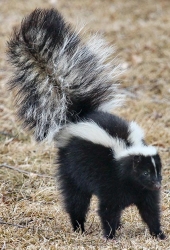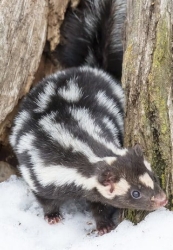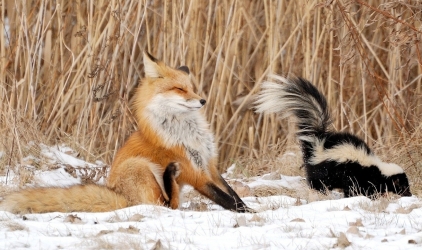 Skunks are stout, small animals with stumpy legs. They have small heads, short, pointed snouts, and small black eyes. Their most distinctive features are the white stripes that run along their backs and extend to the tips of their long, fluffy tails. A mammal, the skunk is best known for its extremely well-developed scent glands that allow it to release a noxious odour in its defense.  Skunks are found primarily in the Western Hemisphere. In Canada they are distributed throughout the provinces, and as far north as the Northwest Territories and Nunavut. They live in farm fields, grasslands, forests, and urban areas. Skunks are found primarily in the Western Hemisphere. In Canada they are distributed throughout the provinces, and as far north as the Northwest Territories and Nunavut. They live in farm fields, grasslands, forests, and urban areas. Although skunks are proficient diggers, they prefer to utilize the abandoned burrows of other animals instead of creating their own. In winter, skunks don't hibernate, but are very inactive, spending most of their time curled up inside their burrows until the arrival of spring. Skunks are primarily nocturnal. Most are about the size of a house cat, but some are significantly smaller. Their average life span in the wild is about three years. The skunk family is composed of four genera (Mephitis, Conepatus, Spilogale, and Mydaus) and 12 species, 10 of which are found in the Western Hemisphere. 
 The common striped skunk (Mephitis mephitis), at left, is found from central Canada south to northern Mexico. Adults are about 80 cm long and weigh 6.3 kg. Their fur is black with a white V down the back, and a white bar between the eyes.
The common striped skunk (Mephitis mephitis), at left, is found from central Canada south to northern Mexico. Adults are about 80 cm long and weigh 6.3 kg. Their fur is black with a white V down the back, and a white bar between the eyes.The Eastern Spotted skunk (Spilogale putorius) at right, is found from southwestern Canada to Mexico. Their spots are actually a series of interrupted stripes running down their back and sides. Spotted skunks are the smallest skunks, about the size of tree squirrels. Skunk scent comes from anal glands located inside the rectum at the base of the tail. All carnivores have anal scent glands, but they are extremely well-developed in skunks. Each of the two glands has a nipple associated with it, and skunks can aim the spray with highly coordinated muscle control. When a skunk is being chased by a predator but can't see it, the spray is emitted as a cloud that the pursuer must run through. This usually is enough to deter most predators. When the skunk has a target to focus on, the spray is emitted as a stream directed at the predator's face. Although accurate to about two metres, its total range is considerably farther.  A skunk will go through a series of threat behaviours before it sprays. Striped skunks will face an adversary head-on and stamp their front paws, sometimes charging forward a few paces or edging backward while dragging their front paws. When they actually spray, they can bend so that they simultaneously face their head and tail at the antagonist. Spotted skunks perform a handstand and approach predators.  The chemical composition of skunk spray differs among species, but sulfur compounds are primarily responsible for its strength. Sulfur has a rotten egg scent, making a skunk's spray extremely pungent. The scent is so strong it can be smelled up to a kilometre away, and can linger for days to weeks. Their spray can also cause stinging of the eyes, temporary blindness, and nausea.
The chemical composition of skunk spray differs among species, but sulfur compounds are primarily responsible for its strength. Sulfur has a rotten egg scent, making a skunk's spray extremely pungent. The scent is so strong it can be smelled up to a kilometre away, and can linger for days to weeks. Their spray can also cause stinging of the eyes, temporary blindness, and nausea. Baby skunks, called kits, can spray when they're just eight days old. That's around two weeks before their eyes open!  Striped skunks spend most of their time on the ground and are less agile than spotted skunks. Striped skunks are omnivorous, feasting on insects, small vertebrates, and eggs, as well as vegetable matter. Striped skunks spend most of their time on the ground and are less agile than spotted skunks. Striped skunks are omnivorous, feasting on insects, small vertebrates, and eggs, as well as vegetable matter. Skunks remain solitary except during the breeding season, though in colder climates females may den together. After mating, the male is driven off, and the female raises the litter of 2 to 12 kits alone. Kits are born from about the end of April through early June. Despite their unique method for defense, skunks are eaten, mostly by great horned owls but also by vultures, eagles and other raptors, crows, coyotes, foxes, dogs, bobcats, mountain lions, American badgers, and even humans. Automobiles are a major cause of mortality for skunks in Ontario and the United States.  Most skunks prey primarily on insects, especially those harmful to agriculture. Skunks are also very useful in destroying rats and mice that commonly infest farm buildings. Spotted skunks are particularly efficient hunters because they are quick and are able to follow rodents into smaller spaces than larger skunks can. However, in some areas of North America, skunks are a major carrier of rabies, which is fatal to skunks. Although striped skunks can be domesticated and their scent glands removed, they do not generally make good pets. Most skunks prey primarily on insects, especially those harmful to agriculture. Skunks are also very useful in destroying rats and mice that commonly infest farm buildings. Spotted skunks are particularly efficient hunters because they are quick and are able to follow rodents into smaller spaces than larger skunks can. However, in some areas of North America, skunks are a major carrier of rabies, which is fatal to skunks. Although striped skunks can be domesticated and their scent glands removed, they do not generally make good pets.
|